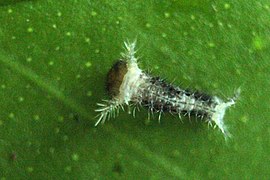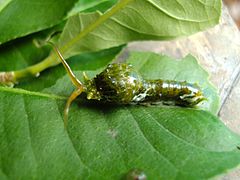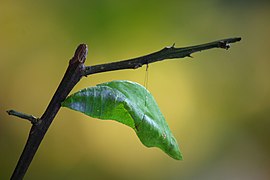Papilio polymnestor
| Papilio polymnestor | ||||||||||||
|---|---|---|---|---|---|---|---|---|---|---|---|---|

Papilio polymnestor , underside of the wing of a male suckling on the ground |
||||||||||||
| Systematics | ||||||||||||
|
||||||||||||
| Scientific name | ||||||||||||
| Papilio polymnestor | ||||||||||||
| Cramer , 1776 |
Papilio polymnestor is a butterfly ( butterfly ) from the family of the knight butterfly (Papilionidae)occurring in Asia. Since 2015 it has been the state butterfly of the Indian state of Maharashtra .
features
The wingspan of the moth is 120 to 140 millimeters. The species is characterized by a slight sexual dimorphism . In the males, a light blue band, which is divided by a black vein markings, runs over the submarginal region of the black upper side of the forewing. The upper side of the hind wing is light blue and interrupted by two rows of black spots. The females are similar to the males, but differ in the whitish colored drawing elements. Usually a short reddish stripe stands out near the wing root. All the drawings on the upper side are also present on the underside of the wing, but the light blue or white has been replaced by a yellow-gray. Red spots stand out directly at the base of the wings. The hind wings do not have tails.
Pre-imaginal stages
The egg has a yellow color, a spherical shape and a smooth surface.
The caterpillars are initially brown-gray in color. There are long, white, branched thorns on each side of the head and anus. When fully grown, they take on a green color and have a smooth surface. A whitish, marbled, sloping band stands out in the middle of the body. There is a large, saddle-like bulge behind the head. To deter predators, the caterpillars are able to turn out an osmaterium .
The doll has a curved shape and is colored green. It is attached to branches as a belt doll .
Caterpillar with osmaterium
Distribution, subspecies and habitat
The species occurs in India and Sri Lanka . In addition to the native form P. p. It is polymnestor in Sri Lanka by the subspecies P. p. parinda ( Moore , [1881]). Papilio polymnestor inhabits evergreen, moist deciduous forests as well as wooded urban and rural areas. Through the cultivation of lemon , lime and orange species (the food plants of caterpillars) in plantations, the range of the species has expanded in recent years.
Way of life
The moths fly in successive generations and are particularly numerous during the monsoon season . Occasionally they suck on damp ground or mud puddles to absorb fluids and minerals. The eggs are preferably laid individually on freshly emerging shoots. The caterpillars feed on the leaves of citrus plants ( Citrus ) and Garcinia xanthochymus . From the hatching of the caterpillars from the egg to pupation it takes an average of 19 to 20 days after five stages of development.
Individual evidence
- ↑ Blue Mormon declared state butterfly. In: The Times of India . Retrieved January 30, 2018 .
- ↑ Distribution and subspecies
- ↑ Channa NB Bambaradeniya: The Fauna of Sri Lanka: Status of Taxonomy, Research, and Conservation. IUCN Colombo, Sri Lanka & Government of Sri Lanka, 2006, ISBN 955-8177-51-2 .
- ↑ G. Mathew, CF Binoy: migration of butterflies (Lepidoptera: Rhopalocera) in the New Amarambalam Reserve Forest of the Nilgiri Biosphere Reserve. In: Zoos' Print Journal. No. 17 (8), 2002, pp. 844-847. doi: 10.11609 / jott.zpj.17.8.844-7
- ^ Charles Thomas Bingham: The Fauna of British India, including Ceylon and Burma. Butterflies. Vol. II, Taylor & Francis, London 1907.
- ↑ NB Rajeswari, D. Jeyabalan: Studies on biology and reproduction of butterflies (family: papilionidae) in Nilgiris Hills. In: International Journal of Advanced Research in Biological Sciences. Vol. 4 (2), 2017, pp. 1–11.
Web links
- Lepiforum e. V. - Blue Mormon in the Lepiforum
- ifoundbutterflies.org - Butterflies of India
- eol.org - Encyclopedia of Life






